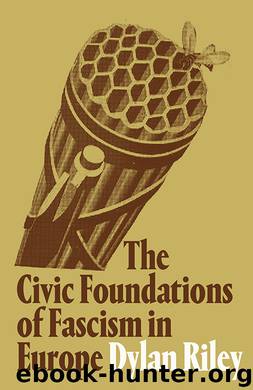The Civic Foundations of Fascism in Europe by Dylan Riley

Author:Dylan Riley
Language: eng
Format: epub
Publisher: Verso Books
The Rise of Statist Fascism (1937–1940)
The above section has shown how a mass fascist movement in Romania emerged out of the failure of counterhegemony. Codreanu’s party became a significant political force by championing the interests of peasants and workers and demanding an end to corruption. This placed Romania’s fascist movement at loggerheads with the Romanian state. Yet the existence of a mass fascist movement presented the monarch in particular with an opportunity for creating a new mass regime, one that he tried to exploit with some success in the late thirties. However, international events conspired to undermine this project, leading to the ambiguous dictatorship of Ion Antonescu (1882–1946).
Carol’s attempt to establish a dictatorship, as I argued above, faced resistance from the forces who were most closely allied to the monarch—particularly the young liberals around Tătărescu. The 1937 elections removed these constraints because of their devastating consequences for the PNL. Despite the fact that the liberal list won a plurality of the vote (36%), in the conditions of interwar Romania this indicated a massive failure, for the cabinet had been unable to engineer an electoral margin that would trip the “government bonus” mechanism established by the 1926 electoral law.95 In contrast, the PNŢ and the TPŢ between them had won over 35 percent of the vote and together had a right to the same number of seats in the chamber as the PNL. Enmity between the PNŢ and the national liberals precluded a government of national concentration based on an alliance between the main “democratic” forces. A legionary-peasant government was a theoretical possibility, but Carol had already decided prior to the voting to appoint the anti-Semitic Octavian Goga (1881–1938) as premier in the event of a liberal defeat.96
Codreanu’s TPŢ had, in contrast to the national liberals, achieved a major victory. This organization in 1937 had 272,000 members, comprising 1.5 percent of the population.97 It won about 16 percent of the vote, just 4 points behind the PNŢ. As I have shown there were serious tensions between the monarchy and the legion. Codreanu fiercely resisted all overtures to link himself to the monarchy. The most spectacular manifestation of the legion’s resistance to Carol was the establishment of an electoral pact with the PNŢ in November of 1937. Codreanu’s group thus entered the elections as a prominent member of a coalition of political forces dedicated to limiting the arbitrary power of the king.
The relationship between Carol and the legion was more ambiguous than these facts suggest. Up until 1933 Codreanu’s movement was generally monarchist. Carol hoped to come to terms with the organization as late as 1937. It is important to stress that the antiguardist repression of the thirties was virtually all initiated by powerful figures among the national liberals, and not by the monarch himself.98 On the contrary important players within the royal camarilla provided substantial financial support to Codreanu’s movement.99 Despite considerable repression, the courts and the police were relatively lenient concerning legionary crimes, and Carol appears to have entertained the hope of using the movement as a support for his own ambitions.
Download
This site does not store any files on its server. We only index and link to content provided by other sites. Please contact the content providers to delete copyright contents if any and email us, we'll remove relevant links or contents immediately.
| Anarchism | Communism & Socialism |
| Conservatism & Liberalism | Democracy |
| Fascism | Libertarianism |
| Nationalism | Radicalism |
| Utopian |
The Secret History by Donna Tartt(18840)
The Social Justice Warrior Handbook by Lisa De Pasquale(12141)
Thirteen Reasons Why by Jay Asher(8791)
This Is How You Lose Her by Junot Diaz(6778)
Weapons of Math Destruction by Cathy O'Neil(6139)
Zero to One by Peter Thiel(5684)
Beartown by Fredrik Backman(5594)
The Myth of the Strong Leader by Archie Brown(5421)
The Fire Next Time by James Baldwin(5246)
How Democracies Die by Steven Levitsky & Daniel Ziblatt(5127)
Promise Me, Dad by Joe Biden(5087)
Stone's Rules by Roger Stone(5026)
100 Deadly Skills by Clint Emerson(4840)
A Higher Loyalty: Truth, Lies, and Leadership by James Comey(4840)
Rise and Kill First by Ronen Bergman(4701)
Secrecy World by Jake Bernstein(4640)
The David Icke Guide to the Global Conspiracy (and how to end it) by David Icke(4624)
The Farm by Tom Rob Smith(4434)
The Doomsday Machine by Daniel Ellsberg(4415)
